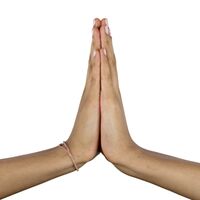Difference between revisions of "Anjali"
Jump to navigation
Jump to search
(Created page with "{{Infobox mudra | mudra = Anjali | image_name = Anjali.jpg | meaning = Prayer or salutation }} '''Anjali''' Category:Mudras") |
(Description and Application) |
||
| Line 5: | Line 5: | ||
}} | }} | ||
| − | '''Anjali''' | + | '''Anjali''' is one of the most common hand gestures, used in dance and yoga, to show prayer and salute another individual. As part of the spiritual side of culture of the East and West, the Anjali mudra is also used to humble oneself and to surrender to the greatness of life. |
| + | |||
| + | ==Application== | ||
| + | |||
| + | The Anjali mudra is used when bowing to deities, teachers, and/or highly respected individuals. For deities, the hands are held high above the head. For elders and teachers, in front of the face, and in front of the chest for general respect. There are many other uses for this mudra as well, including: | ||
| + | |||
| + | * showing obedience | ||
| + | |||
| + | * clapping a beat | ||
| + | |||
| + | * indicating a form of Shiva | ||
| + | |||
| + | * meditation | ||
| + | |||
| + | * awaiting instruction from one's guru | ||
[[Category:Mudras]] | [[Category:Mudras]] | ||
Latest revision as of 11:18, 6 July 2013
| Meaning | Prayer or salutation |
|---|---|
Anjali is one of the most common hand gestures, used in dance and yoga, to show prayer and salute another individual. As part of the spiritual side of culture of the East and West, the Anjali mudra is also used to humble oneself and to surrender to the greatness of life.
Application
The Anjali mudra is used when bowing to deities, teachers, and/or highly respected individuals. For deities, the hands are held high above the head. For elders and teachers, in front of the face, and in front of the chest for general respect. There are many other uses for this mudra as well, including:
- showing obedience
- clapping a beat
- indicating a form of Shiva
- meditation
- awaiting instruction from one's guru
